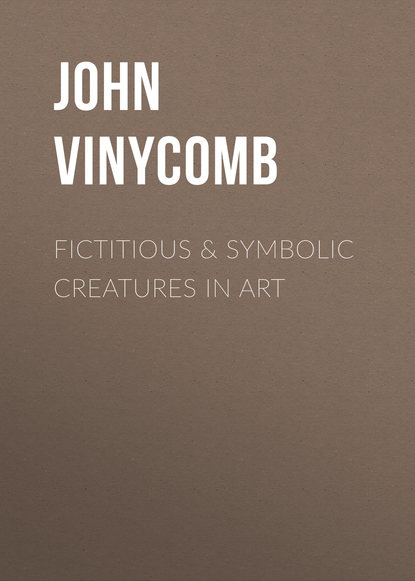 Полная версия
Полная версияFictitious & Symbolic Creatures in Art
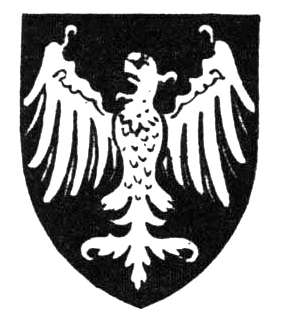
Alerion displayed.
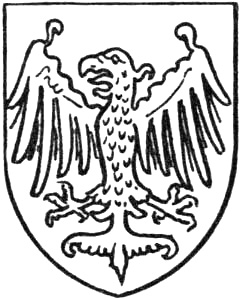
Heraldic Eagle.
The letters of the word Alerion appear to be merely an anagram formed by the same letters Loraine, and may account for the birds on the shield (probably eaglets) being called alerions.
The eagle displayed and the two-headed eagle are but extreme conventionalised representations of the natural bird.
The Liver (Cormorant)
Liver, a fabulous bird, supposed to have given its name to Liverpool and commemorated in the arms of that city. It is traditionally described as a bird that frequented the pool, near which the town was afterwards founded. The arms granted in 1797 are thus blazoned: Argent a cormorant, in the beak a branch of seaweed all proper, and for crest, on a wreath of the colours, a cormorant, the wings elevated, in the beak a branch of Laver proper. It is more than probable that the bird on the arms suggested the name “Liver” being applied to it. The fiction naturally arose from the desire to find a derivation for the name of the town. It is, however, always depicted as a cormorant. On the shield the bird is always depicted with the wings close, and on the crest the wings are elevated.
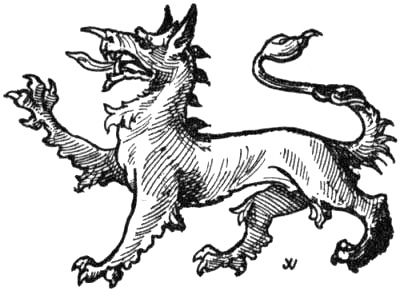
An Heraldic Tigre passant.
The Heraldic Tigre or Tyger
The tigre or tyger of the old heralds still holds its place in English armory, retaining the ancient name to distinguish it from the natural tiger, to which it bears but little resemblance except the name. The early artists probably had no better authority for the strange creature they depicted than the wild tales of Eastern travel and their own lively imaginations. The habit of drawing in a conventional manner may also have assisted in producing such a monster. This type of wild and ruthless ferocity, approaching the draconic in its power and destructiveness, was to their minds fitly suggested by exaggerations of those attributes of savageness and bloodthirstiness with which it was supposed to be endowed. Shakespeare makes King Henry V., when urging on his “noblest English” and “good yeomen” to the assault at Harfleur, declare that
“When the blast of war blows in our earsThen imitate the action of the tiger;Stiffen the sinews, summon up the blood,Disguise fair Nature with hard-favoured rage.”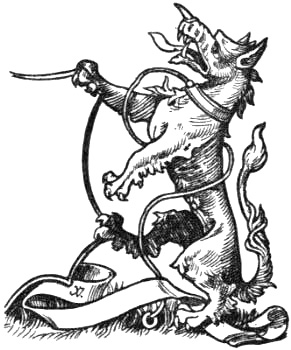
Supporter, an Heraldic Tigre, collared and lined.
“The tyger,” says Bossewell, “is a beast wonderful in strength, and most swift in flight as it were an arrow. For the Persians call an arrow tygris. He is distinguished with diverse speckes; and of him the floode Tygris tooke the name. It is said Bacchus used these beastes in his chariot, for their marveilous swiftness in conveying of the same.”
The heraldic tigre, the invention of the early heralds, is depicted as having the body similar to a wolf, but more strong and massive; powerful jaws armed with prominent canine tusks, and with a short curved horn or spike at the end of his nose. A row of knotted tufts of hair adorn the back of his neck as a mane; tufts also on his breast and thighs, and with strong claws; the tail of a lion completes his equipment. He is a most effective creature in a heraldic emblazonment, especially when “armed” and “tufted” of tinctures differing from his body.
The sinister supporter of the Marquess of Dufferin and Ava is an heraldic tigre ermine, gorged with a tressure flory counter flory or.
Gules a chevron argent, between three tigres, &c., of the second.—Butler, Calais.
Vert, a tigre passant or, maned and tufted argent.—Love, Norfolk (granted 1663).
Or, a tigre passant gules.—Lutwych, Lutwich, Salop.
Baron Harlech has for dexter supporter, and also for crest, an heraldic tigre argent, maned and tufted sable.
The tigre and mirror is an uncommon but very remarkable bearing. Amongst other remarkable ideas which our ancestors entertained respecting foreign animals, “some report that those who rob the tigre of her young use a policy to detaine their damme from following them by casting sundry looking-glasses in the way, whereat she useth to long to gaze, whether it be to beholde her owne beauty or because when she seeth her shape in the glasse she thinketh she seeth one of her young ones; and so they escape the swiftness of her pursuit.”21
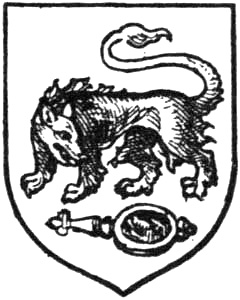
Tigre and Mirror.
“Argent, a tigre passant regardant looking into a mirror lying fessways, the handle to the dexter all proper,” is said to have been the coat of Hadrian de Bardis (probably an Italian), Prebendary of Oxfordshire. These arms still remain, or were lately remaining, in a window of Thame Church. Only two other examples occur, viz.:
“Argent a tigre and mirror (as before) gules.”—Sibell, Kent.
The Royal Tiger
Next to the lion in power is the tiger, an animal not possessed of the noble qualities of the lion, being fierce without provocation, and cruel without cause. The chief difference of the tiger from every other animal of the mottled kind is in the shape of the spots on the skin, which run in streaks or bands in the direction of the ribs. The leopard, panther and the ounce are all, in a certain degree, marked like this animal, except that the lines are broken by round spots, which cover the whole surface of the skin. The use of the royal tiger in modern coats of arms is frequent, and has reference to services in the East.
Outram, Bart., has for supporters: two royal Bengal tigers guardant proper, gorged with a wreath of laurel vert, crowned with an Eastern crown.
Note.—In a heraldic description (or blazon as it is termed) it is necessary for the sake of greater clearness, and to prevent confusion, to name the older mythical creature the “Heraldic Tigre,” that it may not be confounded with its natural representative usually called the “Royal Tiger.”
Leopard, or Panther, Felis Pardus, Lybbarde
A curious character, partly real and partly fictitious has been ascribed to the lybbard or leopard of heraldry. It was said to be the offspring of a lioness and a panther, the Northmen or Normans, according to some authorities, having adopted that beast of prey, noted for rashness, as typical of themselves, so characterised by boldness and impetuosity. The standard of Rollo, first Duke of Normandy, they say, bore a leopard. A second lion or leopard was added to the Norman shield when the county of Maine became annexed to the Duchy of Normandy; and the two lions or leopards—for they are indiscriminately so termed—were thus borne, it is said, upon the standard of William the Conqueror, and by his descendants. A third lion was added by Henry II. on his marriage with Eleanor of Aquitain, a lion being also the arms of that province.
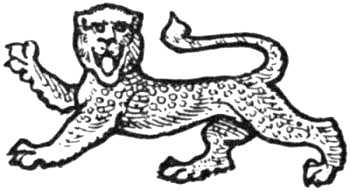
A Leopard passant.
It has been keenly contested whether the three animals in the royal shield of England were lions or leopards. The subject has been ably treated by Mr. J. R. Planché in the “Pursuivant of Arms,” and also by Charles Boutell, M.A., in several of his works. The case seems to stand thus:
In ancient coats the name is believed to be given to the lion in certain attitudes. The French heralds call a lion passant a leopard. Thus Bertrand du Guesclin, the famous Breton, declared that men “devoyent bien honorer la noble fleur-de-lis, qu’ils ne faissaient le félon liépard,” and Napoleon, strongly to excite the valour of his soldiers, exclaimed, “Let us drive these leopards (the English) into the sea!”
“Lion Léoparde” is the term used in French heraldry for the lion when borne passant guardant as in the royal shield of England. When rampant they call it “léoparde lionné,” as if in this attitude the leopard assumed the position and bold character of the lion. The attitude passant guardant thus denoted the peculiar stealthy tread and cat-like watchfulness of the leopard and panther.
The Emperor Frederick II. (1235) sent King Henry of England three leopards as a present in token of his armorial bearings.

A Leopard’s Face, jessant-de-lis.
It is a great argument in favour of the substitution of the lion for the leopard, Mr. Boutell thinks, that the latter should have almost disappeared from English heraldry, the face and head only retaining their place in modern coats.
“A leopard’s head” should show part of the neck, couped or erased, as the case may be; guardant, affronté or front face, is always to be understood of the leopard, and never in profile.
“A leopard’s face” shows no part of the neck, and in conjunction with the term “jessant-de-lis” is used with respect to a leopard’s face having a fleur-de-lis passing through it.
The insignia of the See of Hereford is: gules three leopards’ heads reversed jessant-de-lis, or.
In heraldry the leopard represents those brave and generous warriors who have performed some bold enterprise with force, courage, promptitude, and activity. Thus Shakespeare alludes to the character of the bold soldier
“Full of strange oaths, and bearded like the pard,Jealous in honour, sudden and quick in quarrel,Seeking the bubble reputationEven in the cannon’s mouth.”In Christian Art the leopard is employed to represent that beast spoken of in the Apocalypse, with seven heads and ten horns. Six of the heads are nimbed, but the seventh, being “wounded to death,” has lost its power, and consequently has no nimbus.
Three leopards passant guardant or, pelletée, appear on the arms of the Marquis of Downshire. It is also the sinister supporter.
The supporters of the town of Aberdeen are leopards.
Sable three leopards rampant argent spotted sable are given as the arms of Lynch. It is, however, probable that the lynx was the animal originally blazoned as “arms parlantes” for the name.
Ermine on a cross patonce sable, a leopard’s head, issuing out of a ducal coronet or, crest, a demi-leopard erect, proper.—Dickens.
A leopard’s face, breaking with his mouth a sword, is the crest of Disne.
The supporters of the Earl of Northesk are two leopards reguardant.
The leopard or panther, says Dr. P. M. Duncan, F.R.S.,22 was the only one of the greater feline animals, except the lion and tiger, which seems to have been known to the ancients. It is always represented as drawing the chariot of Bacchus, and the forlorn Ariadne is sculptured as riding on one of the spotted steeds of her divine lover. The panther was also constantly used in the barbarous sports of the amphitheatre, and, in common with the lion and tiger, has been both executioner and grave to many a bold-hearted martyr.
The leopard’s skin was a favourite mantle in the olden times in Greece. In the “Iliad,” Homer, speaking of Menelaus, says:
“With a pard’s spotted hide his shoulders broadHe mantled o’er,”and the leopard, or panther, is given in the “Odyssey” as one of the forms assumed by Proteus, “the Ancient of the Deep.”
A curious ancient superstition about the leopard is embodied in its name. It was thought not to be actually the same animal as the panther or pard, but to be a mongrel or hybrid between the male pard and the lioness, hence it was called the lion-panther, or leopardus. This error, as Archbishop Trench tells us, “has lasted into modern times”; thus Fuller: “Leopards and mules are properly no creatures.”
Some writers, says Boutell, describe the leopard as the issue of the pard and lioness, and they assign the unproductiveness of such hybrids as a reason for its frequent adoption in the arms of abbots and abbesses. “Mulus et abbates sunt in honore pares.”
The leopard and panther are now acknowledged to be but slight varieties of the same species. In Wood’s “Natural History” some slight difference is mentioned as to the number of spots. “The panther is fawn-coloured above, white underneath, with six or seven ranges of patches resembling rosettes—that is to say, each composed of an assemblage of five or six simple black spots. It very much resembles the leopard, which inhabits the same region (but has ten rows of spots which are of smaller size), It is the wildest of the feline tribe, always retaining its fierce aspect and perpetual growl.”
The Panther “Incensed”
“The panther, knowing that his spotted hideDoth please all beasts, but that his looks them fray,Within a bush his dreadful head doth hideTo let them gaze, while he on them doth prey.”Spenser, Sonnet.This beast, like the leopard, has been the object of much mistaken or fictitious history. Pliny, who is responsible for many of the errors in natural history since his time, says of the panther: “It is said that all four-footed beasts are wonderfully delighted and enticed by the smell of panthers; but their hideous looke and crabbed countenance which they bewray so soon as they show their heads skareth them as much again: therefore their manner is to hide their heads, and when they have trained other beasts within their reach by their sweet savour, they fall upon them and worry them.”23 And again, Sir William Segar, Garter King-of-Arms, following the same credulous historian, says: “The panther is admired of all other beasts for the beauty of his skyn, being spotted with variable colours, and beloved of them for the sweetness of his breath that streameth forth of his nostrils and ears like smoke which our paynters mistaking, corruptly do make fire.”24
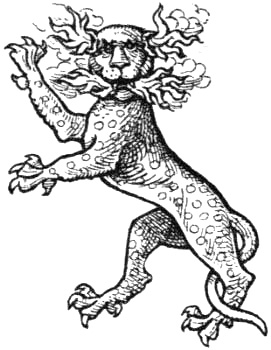
Panther incensed.
It is, however, more probable that the creature was represented emitting flame and smoke to denote and give characteristic expression to the native savagery of the brute when irritated. If one can imagine the terror inspired by remorseless and unpitying fury, sudden and impetuous, we see its object fairly typified in the panther “incensed.” The idea of fire and smoke darting from its mouth, eyes and ears was doubtless suggested by that habit peculiar to the feline race, observable even in the domestic cat, to “spit fire” and “swear” when rudely attacked, and as an emblem in this sense it is extremely well indicative of sudden fury.
Guillam says: “Some authors are of opinion that there are no panthers bred in Europe; but in Africa, Lybia and Mauritania they are plentiful. The panther is a beast of a beautiful aspect, by reason of the manifold variety of his divers coloured spots wherewith his body is overspread. As a lion doth in most things resemble the nature of a man, so, after a sort, doth the panther of a woman; for it is a beautiful beast, and fierce, yet very loving to their young ones, and will defend them with the hazard of their own lives; and if they miss them, they bewail their loss with loud and miserable howling.”
The Lancastrian badge “the panther,” says Planché, “which is attributed by Sir William Segar to Henry VI. and blazoned passant guardant argent spotted of all colours with vapour issuant from her mouth and ears; but there is no authority quoted for it, and there is no example extant, the only collateral evidence being the supporters of the Somerset Dukes of Beaufort, who are supposed to have used it as a token of their Lancastrian descent.” The dexter supporter of the Duke of Beaufort thus is blazoned: Dexter, a panther argent, semée of torteaux, hurts and pomies alternately, flames issuant from the mouth and ears proper, gorged with a plain collar, chained, or.
The heraldic panther, or as it is more frequently termed, a panther incensed, is always borne guardant, i.e., full-faced; and “incensed,” that is to say, it is depicted with flames and smoke issuing from its mouth and ears. Its coat is spotted of various tinctures as the blazon may state.
Odet de Foix, Sieur de Lautrec, Marshal of France (+ 1528) being considered a person of fierce appearance, took for device a panther, with the motto “Allicit ulterius” (“He entices further”), alluding to the attractive power of that animal notwithstanding its fierce exterior, “an evidence,” remarks a modern writer, “that he had as much vanity as ambition.”
The town of Lucca for arms bears a panther: “La pantera, che Lucca abbraccia e onora.”
Gian Giacomo Trivulzio, surnamed the Great (+ 1518), a celebrated Italian soldier, bore a panther on his standard, with the motto, “Mens sibi conscia facti” (“The mind conscious to itself of the deed”), the panther signifying foresight (providence) from the number of eyes in his coat. Others said he wished to imply that he knew how to manage for himself in the various changes of his capricious fortune.25
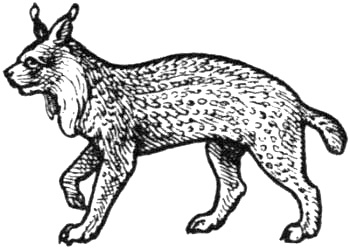
The Lynx.
The Lynx
Felis Lynx, or mountain cat, is found in the northern parts of Europe, Asia and America, and climbs the highest trees. He preys on squirrels, deer, hares, &c. He is fond of blood and kills great numbers of animals to satisfy his unconquerable thirst. He is smaller than the panther, about three feet and a half in length, his tail is much shorter and black at the extremity. His ears are erect with a pencil of black hair at the tips. The fur is long and thick, the upper part of the body is a pale grey, the under parts white.
The sight of the lynx is said to be so piercing that the ancients attributed to it the faculty of seeing through stone walls: it may, however, be asserted with truth that it distinguishes its prey at a greater distance than any other carnivorous quadruped. On this account it is frequently employed in heraldry, symbolising watchfulness, keenness of vision, and also the ability to profit by it.
Lynx-eyed, “oculis lynceis,” originally referred to Lynceus, the argonaut, who was famed for the keenness of his vision; then it was transferred to the lynx and gave rise to the fable that it could see through a wall (notes to “Philobiblon,” by E. C. Thomas).
The Accademia de Lincei, founded in Rome in 1603, with the object of encouraging a taste for natural history, adopted the name and device of the lynx because the members should have the eyes of a lynx to penetrate the secrets of nature. Galileo, Fabio Colonna, and Gianbattista Porta were among the members of the academy, the latter philosopher and mathematician, who was the inventor of the camera obscura, bore the device of the academy, the lynx, and the motto “Aspicit et inspicit” (“Looks at and looks into”).
Charles IV. of Luxemburg, Emperor of Germany, adopted the lynx for his impress, with the motto, “Nullius pavit occursum” (“He fears not meeting with any one”).
The Lizard Lynx is an animal of the lynx or wild cat kind of a dark brown colour, spotted black; the ears and tail are short. They are frequent in the woods of Sweden, Denmark and Norway, where they are usually termed lizards.
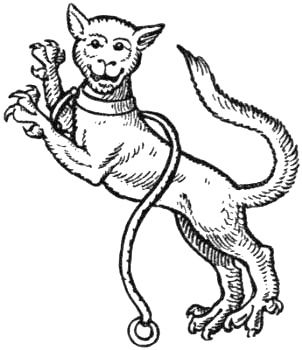
Cat-a-Mountain saliant, collared and lined.
Cat-a-Mountain—Tiger Cat or Wild Cat
The Clan Chattan, who gave their name to the county of Caithness, bore as their cognisance the wild mountain cat, and called their chieftain, the Earl of Sutherland, “Mohr an chat” (The Great Wild Cat). The Mackintoshes still bear as their crests and supporters these ferocious cats, with the appropriate warning as a motto, “Touch not the cat but a glove.”
The whole is a pun upon the word “Catti,” the Teutonic settlers of Caithness, i.e., Catti-ness, and means “Touch not the Clan Cattan (or mountain cat) without a glove.” Here “but” is used in the original meaning, beout, i.e., without. For another example of “but” meaning without, see Amos iii. 7. The same words are also used as the motto of several Scottish families.
None will forget how the cat-a-mountain showed her claws to the Clan Kay, in the Wynds of Perth in Sir Walter Scott’s “Fair Maid of Perth.”
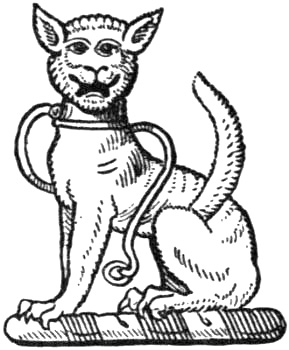
Crest, a Cat-a-Mountain, sejant, collared and lined.
The Heraldic Musion.—Bossewell, in his work on heraldry published 1572, describes a musion as “a beaste that is enimie to myse and rattes.” He adds also that he is “slye and wittie, and seeth so sharply, that he overcommeth darkness of the nighte by the shyninge lighte of his eyne. In the shape of body, he is like unto a leoparde, and hath a greate mouthe. He doth delighte that he enjoyeth his libertie, and in his youthe he is swifte, plyante, and merrie. He maketh a rufull noyse, and a gastefull when he proffereth to fighte with another. He is a cruel beaste when he is wilde and falleth on his owne feet from moste high places, and uneth (scarce) is hurte therewith. When he hathe a fayre skinne, he is, as it were, prowde thereof, and then he goeth fast aboute to be seene.”
Childebert, King of France, in token of his having taken captive Gondomar of Bourgogne, assumed the device of a tiger-cat or ounce behind a grating or troillis, gules cloué argent. This recalls the famous scene between Sanglier Rouge and Toison d’Or in “Quentin Durward,” when Charles the Bold’s jester professes to help the unhappy envoy of De la Marck by describing it as a cat looking out of a dairy window.
The cat, though domesticated, is considered as possessed of ingratitude; in its friendship so uncertain and so vicious in its nature, “that,” say old writers, “it is only calculated for destroying the obnoxious race of rats and other small game.”
From the mediæval superstition that Satan’s favourite form was a black cat, it was superstitiously called “a familiar.” Hence witches were said to have a cat as their familiar.
The Cat: A symbol of liberty.—The Roman goddess of Liberty was represented as holding a cup in one hand, a broken sceptre in the other, and a cat lying at her feet. No animal is so great an enemy to all constraint as a cat.
The cat was held in veneration by the Egyptians as sacred to the goddess Bubastis. This deity is represented with a human body and a cat’s head. Diodorus tells us that whoever killed a cat, even by accident, was by the Egyptians punished with death. According to Egyptian tradition, Diana assumed the form of a cat, and thus excited the fury of the giants. The London Review says: “The Egyptians worshipped the cat as a symbol of the moon, not only because it is more active after sunset, but from the dilation and contraction of its orb, symbolical of the waxing and waning of the night goddess.”
In heraldry it should always be represented full-faced like the leopard.
Erminois three cats-a-mountain passant gardant, in pale azure, each charged on the body with an ermine spot or. Crest: a demi cat-a-mountain gardant, azure, gorged with a collar gemel, and charged with ermine spots, two and one.—Tibbets.



